Italian heartthrob Amedeo Nazzari (1907-1979) was the athletic, fearless hero and impeccable gentleman of dozens of popular films during the late 1930s, 1940s and 1950s. Because of his reckless, adventure-seeking film characters, he was compared to Errol Flynn. After the war, he made a comeback opposite Yvonne Sanson in a series of popular crime-melodramas, directed by Raffaello Matarazzo. And he showed an admirable sense of irony in his portrayal of a film star in decline in Fellini’s Le notti di Cabiria (1957).

Vintage postcard.

French postcard by Editions P.I., offered by Les Carbones Korès, Paris, no. 383.
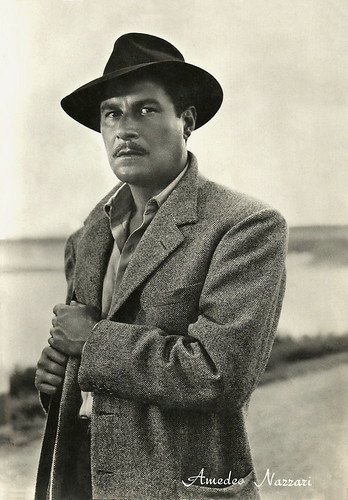
Italian postcard by Rotalfoto, no. 113. Photo: Ponti-De Laurentiis. Probably a still for Il brigante Musolino (1950), costarring Dino De Laurentiis' wife Silvana Mangano.
Amedeo Nazzari was born as Salvatore Amedeo Buffa in Cagliari on the island of Sardinia in 1907. His father, Salvatore Buffa, was a factory owner, and his mother was the daughter of Argenide Amedeo Nazzari, former President of the Court of Appeal of Vicenza. His father died when Amedeo was six, and his mother moved with him and his sisters to Rome.
There, he appeared in school plays. Later, he abandoned his engineering studies for a career in the theatre. He made his professional debut with the company of Dillo Lombardi in 1927. In later years, he worked for major companies like those of Annibale Ninchi, Memo Benassi and Marta Abba.
In 1935, he was noticed by Elsa Merlini, who offered him a part in her next film. This film, Almieri of Geneva (1936), was not a success, and Nazzari returned to the theatre. Once again, an actress noticed him: the young Anna Magnani, who insisted that her husband, director Goffredo Alessandrini, would give Amedeo a part in his new film, Cavalleria / Cavalry (1936).
Amedeo's athletic figure and fascinating presence became the main attraction of the film, which was presented at the Venezia alla Mostra del Cinema (the Venice Film Festival) and then became one of the greatest box office hits in Italian cinemas that year.
Another film role in uniform, in Luciano Serra pilota / Luciano Serra, pilot (Goffredo Alessandrini, 1938), gave him his second popular success. Although the film was made under the Fascist regime, it is terse and not at all bogged down by rhetoric, according to F.T. at the Italica website of Rai Internazionale. Nazzari was now a familiar face and received many film offers. His continuing discussions with film-makers about how to interpret dialogues and his suggestions to change scripts gave him the reputation of being difficult and rebellious.

Italian postcard by Ballerini & Frattini Firenze Ed., no. 2408. Photo Vaselli / Radio RKO Generalcine.
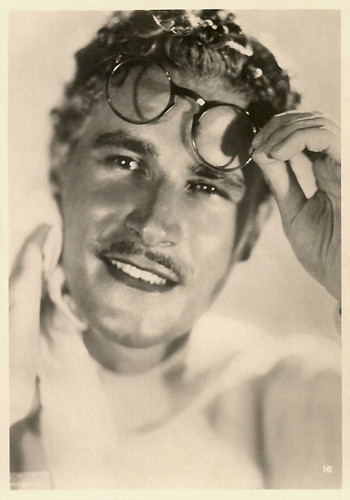
Italian postcard by ASER (A. Scaramaglia Edizioni Roma), 1941.

Italian postcard. Lilia Silvi and Amedeo Nazzarri in Giorni felici / Happy Days (Gianni Franciolini, 1942).
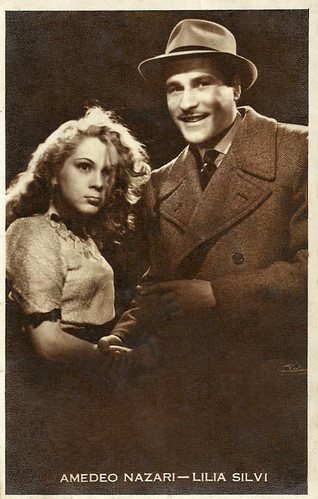
Italian postcard. Lilia Silvi and Amedeo Nazzari in La bisbetica domata / The Taming of the Shrew (Ferdinando Maria Poggioli, 1942).
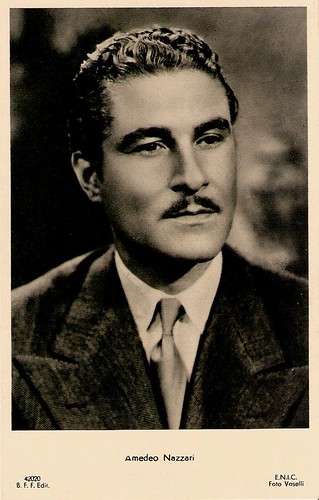
Italian postcard by Casa Editrice Ballerini & Fratini (B.F.F. Edit.), Firenze, no. 42020. Photo: Voselli / E.N.I.C.
In 1941, Amedeo Nazzari received the Volpi Cup for Best Actor at the ninth Venice Film Festival. He was awarded for his role in Caravaggio, il pittore maledetto / Caravaggio, the cursed painter (Goffredo Alessandrini, 1941) opposite Clara Calami.
A huge success was the costume drama La cena delle beffe / The Dinner of the Practical Jokes (Alessandro Blasetti, 1941). This celebrated adaptation of the Sem Benelli play definitively confirmed his status as a film star. In this historical drama, he had a striking resemblance to Errol Flynn. The film created a sensation with the first topless nude scene in a mainstream Italian film. In a brief but startling scene, luminous leading lady Clara Calami's blouse is ripped off by the lusty Nazzari.
On IMDb, Mario Gauci writes: “the film is stylish and handsomely mounted - though its stage origins are betrayed by being mostly filmed in interiors. Still, the highly intriguing plot - with its many twists and turns (particularly towards the ironic, even Shakespearean, finale) - keeps one compelled to watch, and the performances are all quite good”.
After some smaller films and a difficult period after the war, he returned in grand style in the war drama Un giorno nella vita / A Day in the Life (Alessandro Blasetti, 1946), the crime drama Il bandito / The Bandit (Alberto Lattuada, 1946) opposite Anna Magnani, and the Alexander Pushkin adaptation La figlia del capitano / The Captain's Daughter (Mario Camerini, 1946) with Vittorio Gassman.
Internationally, he was also in high demand. He first went to Spain to appear in three films by Ricardo Gascón, and then moved to Argentina. When he refused to play a criminal and corrupt Italian and so to defame his country, even Evita Peron came to his defence. He returned to Italy in 1949 and appeared with Silvana Mangano in the compelling melodrama Il lupo della Sila / The Lure of the Sila (Duilio Coletti, 1949), and with Greek actress Yvonne Sanson in Catene / Chains (Raffaello Matarazzo, 1949).
Catene was the start of a second period of film successes for Nazzari. With Sanson and director Raffaello Matarazzo, he made a series of ‘strappalacrime’, crime-melodramas which were despised by the film critics but loved by the public. Among this series were also Tormento / Torment (1950), I figli di nessuno / Nobody’s Children (1951), and Torna! / Go! (1954). In Italy, these films became a camp phenomenon among B-film fans in the 1970s.

Italian postcard by B.F.F. Edit., Firenze, no. 2263. Photo: E.N.I.C.
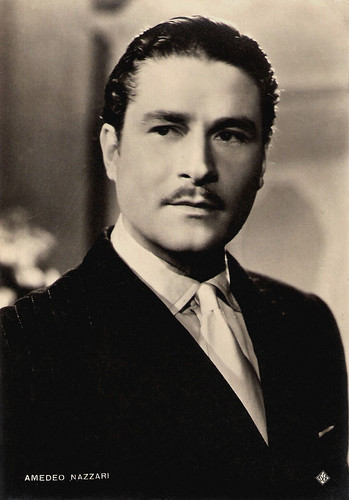
Italian postcard by ASER (A. Scaramaglia Edizioni, Roma), no. 10. Photo: Lux Film / Vaselli, Roma.

German postcard by Kolobri-Verlag. Photo: Lux / Schorchtfilm. Publicity still for Il brigante Musolino / Fugitive (Mario Camerini, 1950).
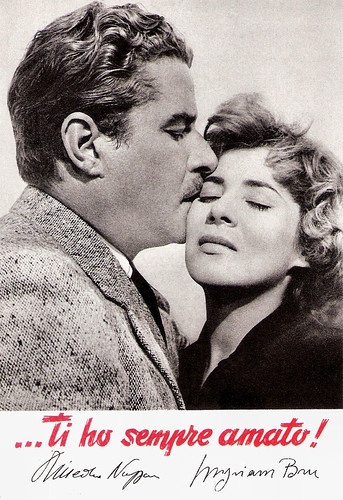
Italian promotion card by D.E.A.R. Film. Photo: Rizzoli / Royal Film / D.E.A.R. Film. Publicity still for ...ti ho sempre amato! / I Always Loved You (Mario Costa, 1953) with Myriam Bru.
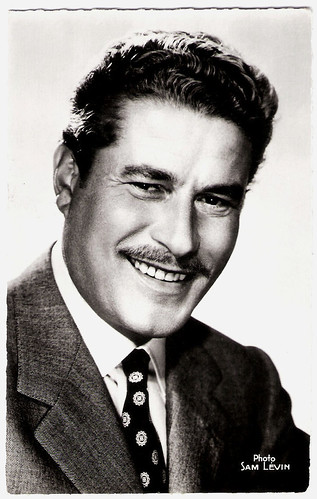
French postcard by Editions du Globe, Paris, no. 461. Photo: Sam Lévin.
During the 1950s, Amedeo Nazarri also appeared in more serious films. In Processo alla città / The City Stands Trial (Luigi Zampa, 1952), he played a judge who opposes the Neapolitan Camorra, and in Proibito/Forbidden (Mario Monicelli, 1955), starring Mel Ferrer, he had for the first time the opportunity to play a character in a Sardinian history of family feuds.
In 1957, he gently chided his virile, romantic screen image as the self-absorbed film-star-in-decline opposite Giulietta Masina in the Oscar-winning Le notti di Cabiria / Nights of Cabiria (Federico Fellini, 1957). Here, he cocked an eye at himself with an admirable sense of irony. Also in 1957, Nazzari married Greek-Italian actress Irene Genna, and a year later, Maria Evelina Nazzari was born, who is now also a theatre actress.
The 1960s began with two disappointments: the role of Prince Salina in Il Gattopardo / The Leopard (1960), which was offered to him by director Luchino Visconti, then went to Burt Lancaster to raise money from the American producers. Earlier, his role in La tempesta / The Tempest (Alberto Lattuada, 1958), a remake of his La figlia del capitano, was assigned to Van Heflin. From Hollywood came a proposal to make a film with Marilyn Monroe, but this time it was Nazzari himself who refused because of his difficulties with speaking and singing English. The film, Let's Make Love, would be made with Yves Montand. In 1968, he did obtain a part in the Romanian production Columna / The Column (Mircea Dragan, 1968) with Antonella Lualdi and Franco Interlenghi.
In Italy, the golden age of Italian comedy started, but except for some sporadic appearances, Nazzari refused the offers. According to Wikipedia, he explained that it was “a matter of taste and respect for himself and the public”. He only did cameo appearances in international productions like the crime dramas The Poppy Is Also a Flower (Terence Young, 1966) with Senta Berger, Le clan des Siciliens / The Sicilian Clan (Henri Verneuil, 1969) with Jean Gabin, and The Valachi Papers (Terence Young, 1972) starring Charles Bronson. During the 1970s, kidney problems forced him to several hospital admissions. He made a TV remake of La Figlia del capitano / The Captain's Daughter (Leonardo Cortese, 1965), and appeared as a guest on such shows as Il Musichiere (The Musician) Studio Uno and Settevoci. His last film appearances were small roles in A Matter of Time / Nina (Vincente Minnelli, 1976) with Ingrid Bergman, and Melodrammore (Maurizio Costanzo, 1977).
Amedeo Nazzari died in 1979 in a Roman hospital. During his career, he won several awards. He won the Best Actor award at the Venice Film Festival twice, in 1941 and 1947. He was also awarded the Special David di Donatello prize, for a life dedicated to cinema with passionate professionalism and extraordinary success. At Italica, F.T. writes: “Ever faithful to his embodiments of fearless heroes and incorruptible gentleman, Nazzari was an icon of a naïve, provincial Italy that was autarkic at all costs, even in its dreams: but he displayed an ability to shift from ‘Magyar’ comedy to mature roles with impeccable professionalism, the ultimate defining trait of his outstanding career.”
Final scene from La cena delle beffe (1941) with Amedeo Nazzari and Osvaldo Valenti. Source: fusiota73 (YouTube).
Original trailer of Le Notti di Cabiria (1957). Source: TrailerItaliano (YouTube).
Sources: Hal Erickson (AllMovie - Page Now Defunct), F.T. (Italica), Wikipedia (Italian) and IMDb.
This post was last updated on 10 December 2025.

Vintage postcard.

French postcard by Editions P.I., offered by Les Carbones Korès, Paris, no. 383.

Italian postcard by Rotalfoto, no. 113. Photo: Ponti-De Laurentiis. Probably a still for Il brigante Musolino (1950), costarring Dino De Laurentiis' wife Silvana Mangano.
Difficult and rebellious
Amedeo Nazzari was born as Salvatore Amedeo Buffa in Cagliari on the island of Sardinia in 1907. His father, Salvatore Buffa, was a factory owner, and his mother was the daughter of Argenide Amedeo Nazzari, former President of the Court of Appeal of Vicenza. His father died when Amedeo was six, and his mother moved with him and his sisters to Rome.
There, he appeared in school plays. Later, he abandoned his engineering studies for a career in the theatre. He made his professional debut with the company of Dillo Lombardi in 1927. In later years, he worked for major companies like those of Annibale Ninchi, Memo Benassi and Marta Abba.
In 1935, he was noticed by Elsa Merlini, who offered him a part in her next film. This film, Almieri of Geneva (1936), was not a success, and Nazzari returned to the theatre. Once again, an actress noticed him: the young Anna Magnani, who insisted that her husband, director Goffredo Alessandrini, would give Amedeo a part in his new film, Cavalleria / Cavalry (1936).
Amedeo's athletic figure and fascinating presence became the main attraction of the film, which was presented at the Venezia alla Mostra del Cinema (the Venice Film Festival) and then became one of the greatest box office hits in Italian cinemas that year.
Another film role in uniform, in Luciano Serra pilota / Luciano Serra, pilot (Goffredo Alessandrini, 1938), gave him his second popular success. Although the film was made under the Fascist regime, it is terse and not at all bogged down by rhetoric, according to F.T. at the Italica website of Rai Internazionale. Nazzari was now a familiar face and received many film offers. His continuing discussions with film-makers about how to interpret dialogues and his suggestions to change scripts gave him the reputation of being difficult and rebellious.

Italian postcard by Ballerini & Frattini Firenze Ed., no. 2408. Photo Vaselli / Radio RKO Generalcine.

Italian postcard by ASER (A. Scaramaglia Edizioni Roma), 1941.

Italian postcard. Lilia Silvi and Amedeo Nazzarri in Giorni felici / Happy Days (Gianni Franciolini, 1942).

Italian postcard. Lilia Silvi and Amedeo Nazzari in La bisbetica domata / The Taming of the Shrew (Ferdinando Maria Poggioli, 1942).

Italian postcard by Casa Editrice Ballerini & Fratini (B.F.F. Edit.), Firenze, no. 42020. Photo: Voselli / E.N.I.C.
The first topless nude scene
In 1941, Amedeo Nazzari received the Volpi Cup for Best Actor at the ninth Venice Film Festival. He was awarded for his role in Caravaggio, il pittore maledetto / Caravaggio, the cursed painter (Goffredo Alessandrini, 1941) opposite Clara Calami.
A huge success was the costume drama La cena delle beffe / The Dinner of the Practical Jokes (Alessandro Blasetti, 1941). This celebrated adaptation of the Sem Benelli play definitively confirmed his status as a film star. In this historical drama, he had a striking resemblance to Errol Flynn. The film created a sensation with the first topless nude scene in a mainstream Italian film. In a brief but startling scene, luminous leading lady Clara Calami's blouse is ripped off by the lusty Nazzari.
On IMDb, Mario Gauci writes: “the film is stylish and handsomely mounted - though its stage origins are betrayed by being mostly filmed in interiors. Still, the highly intriguing plot - with its many twists and turns (particularly towards the ironic, even Shakespearean, finale) - keeps one compelled to watch, and the performances are all quite good”.
After some smaller films and a difficult period after the war, he returned in grand style in the war drama Un giorno nella vita / A Day in the Life (Alessandro Blasetti, 1946), the crime drama Il bandito / The Bandit (Alberto Lattuada, 1946) opposite Anna Magnani, and the Alexander Pushkin adaptation La figlia del capitano / The Captain's Daughter (Mario Camerini, 1946) with Vittorio Gassman.
Internationally, he was also in high demand. He first went to Spain to appear in three films by Ricardo Gascón, and then moved to Argentina. When he refused to play a criminal and corrupt Italian and so to defame his country, even Evita Peron came to his defence. He returned to Italy in 1949 and appeared with Silvana Mangano in the compelling melodrama Il lupo della Sila / The Lure of the Sila (Duilio Coletti, 1949), and with Greek actress Yvonne Sanson in Catene / Chains (Raffaello Matarazzo, 1949).
Catene was the start of a second period of film successes for Nazzari. With Sanson and director Raffaello Matarazzo, he made a series of ‘strappalacrime’, crime-melodramas which were despised by the film critics but loved by the public. Among this series were also Tormento / Torment (1950), I figli di nessuno / Nobody’s Children (1951), and Torna! / Go! (1954). In Italy, these films became a camp phenomenon among B-film fans in the 1970s.

Italian postcard by B.F.F. Edit., Firenze, no. 2263. Photo: E.N.I.C.

Italian postcard by ASER (A. Scaramaglia Edizioni, Roma), no. 10. Photo: Lux Film / Vaselli, Roma.

German postcard by Kolobri-Verlag. Photo: Lux / Schorchtfilm. Publicity still for Il brigante Musolino / Fugitive (Mario Camerini, 1950).

Italian promotion card by D.E.A.R. Film. Photo: Rizzoli / Royal Film / D.E.A.R. Film. Publicity still for ...ti ho sempre amato! / I Always Loved You (Mario Costa, 1953) with Myriam Bru.

French postcard by Editions du Globe, Paris, no. 461. Photo: Sam Lévin.
Impeccable professionalism
During the 1950s, Amedeo Nazarri also appeared in more serious films. In Processo alla città / The City Stands Trial (Luigi Zampa, 1952), he played a judge who opposes the Neapolitan Camorra, and in Proibito/Forbidden (Mario Monicelli, 1955), starring Mel Ferrer, he had for the first time the opportunity to play a character in a Sardinian history of family feuds.
In 1957, he gently chided his virile, romantic screen image as the self-absorbed film-star-in-decline opposite Giulietta Masina in the Oscar-winning Le notti di Cabiria / Nights of Cabiria (Federico Fellini, 1957). Here, he cocked an eye at himself with an admirable sense of irony. Also in 1957, Nazzari married Greek-Italian actress Irene Genna, and a year later, Maria Evelina Nazzari was born, who is now also a theatre actress.
The 1960s began with two disappointments: the role of Prince Salina in Il Gattopardo / The Leopard (1960), which was offered to him by director Luchino Visconti, then went to Burt Lancaster to raise money from the American producers. Earlier, his role in La tempesta / The Tempest (Alberto Lattuada, 1958), a remake of his La figlia del capitano, was assigned to Van Heflin. From Hollywood came a proposal to make a film with Marilyn Monroe, but this time it was Nazzari himself who refused because of his difficulties with speaking and singing English. The film, Let's Make Love, would be made with Yves Montand. In 1968, he did obtain a part in the Romanian production Columna / The Column (Mircea Dragan, 1968) with Antonella Lualdi and Franco Interlenghi.
In Italy, the golden age of Italian comedy started, but except for some sporadic appearances, Nazzari refused the offers. According to Wikipedia, he explained that it was “a matter of taste and respect for himself and the public”. He only did cameo appearances in international productions like the crime dramas The Poppy Is Also a Flower (Terence Young, 1966) with Senta Berger, Le clan des Siciliens / The Sicilian Clan (Henri Verneuil, 1969) with Jean Gabin, and The Valachi Papers (Terence Young, 1972) starring Charles Bronson. During the 1970s, kidney problems forced him to several hospital admissions. He made a TV remake of La Figlia del capitano / The Captain's Daughter (Leonardo Cortese, 1965), and appeared as a guest on such shows as Il Musichiere (The Musician) Studio Uno and Settevoci. His last film appearances were small roles in A Matter of Time / Nina (Vincente Minnelli, 1976) with Ingrid Bergman, and Melodrammore (Maurizio Costanzo, 1977).
Amedeo Nazzari died in 1979 in a Roman hospital. During his career, he won several awards. He won the Best Actor award at the Venice Film Festival twice, in 1941 and 1947. He was also awarded the Special David di Donatello prize, for a life dedicated to cinema with passionate professionalism and extraordinary success. At Italica, F.T. writes: “Ever faithful to his embodiments of fearless heroes and incorruptible gentleman, Nazzari was an icon of a naïve, provincial Italy that was autarkic at all costs, even in its dreams: but he displayed an ability to shift from ‘Magyar’ comedy to mature roles with impeccable professionalism, the ultimate defining trait of his outstanding career.”
Final scene from La cena delle beffe (1941) with Amedeo Nazzari and Osvaldo Valenti. Source: fusiota73 (YouTube).
Original trailer of Le Notti di Cabiria (1957). Source: TrailerItaliano (YouTube).
Sources: Hal Erickson (AllMovie - Page Now Defunct), F.T. (Italica), Wikipedia (Italian) and IMDb.
This post was last updated on 10 December 2025.
No comments:
Post a Comment